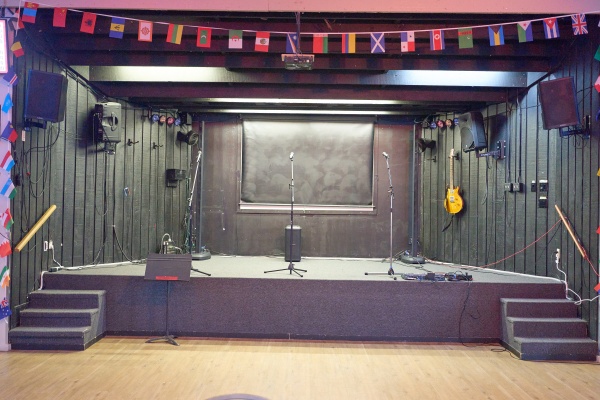Difference between revisions of "Cave Stage"
(Created page with "This is an example of a stage set up on a cave stage. This is how it looked before we added keyboards, e-drums, a backline guitar amp (low volume, miked), and another vocal m...") |
m (→Settings) |
||
| (One intermediate revision by the same user not shown) | |||
| Line 23: | Line 23: | ||
===Room dimensions=== | ===Room dimensions=== | ||
| − | The room is about 3000 square feet (280 square meters) and | + | The room is about 3000 square feet (280 square meters) and approximately 20 feet (6 meters) tall. |
=== Audience=== | === Audience=== | ||
| Line 31: | Line 31: | ||
=== Settings=== | === Settings=== | ||
Running five microphones on this tight stage could have been a problem, so I used these aggressive settings for the noise gates | Running five microphones on this tight stage could have been a problem, so I used these aggressive settings for the noise gates | ||
| − | Comp/Gate Noise Gate | + | ;Comp/Gate Noise Gate |
* Thresh -35 dB | * Thresh -35 dB | ||
* Speed 70% (slower Speed (higher value) gives a more gradual cut-off, and this may sound more natural as a singer naturally lowers their volume at times) | * Speed 70% (slower Speed (higher value) gives a more gradual cut-off, and this may sound more natural as a singer naturally lowers their volume at times) | ||
* Ramp 100% (so the beginnings of phrases are allowed through by ramping up the volume quickly | * Ramp 100% (so the beginnings of phrases are allowed through by ramping up the volume quickly | ||
| − | No Reverb, Delay or other effects | + | ;No Reverb, Delay or other effects |
| + | The room had enough natural reverb that there was no need to add more. On the stage, the vocals didn't sound dry or sterile without reverb because there were ample early side reflections from the stage walls | ||
=== Stage Volume === | === Stage Volume === | ||
Latest revision as of 22:26, 10 August 2024
This is an example of a stage set up on a cave stage.
This is how it looked before we added keyboards, e-drums, a backline guitar amp (low volume, miked), and another vocal microphone. As you can imagine, it was pretty tight once we got everybody on the stage.
- Note
- We did not use the loudspeakers mounted on the side walls of the stage.
Contents
Stage
Here's a cave stage. The stage elevation is 30" (.75 meters). The back of the stage is narrower than the front, and it's not very deep. (approximately 25 feet across the front, 15 feet across the back, 8 feet deep)
Sound Sources
- Four vocal microphones
- Two electric guitars (one with a backline amp, miked. The other running through an amp modeller)
- Sometimes, the electric guitars played acoustic guitars (wireless to the T4S with ToneMatch Presets)
- Electronic drums (with monitors)
- Keyboard (with monitor)
- Electric Bass (direct to the mixer using a ToneMatch Preset)
- T8S mixer daisy chained to a T4S mixer - total - 12 channels available
L1 positions
Given the limited space, I set up the two L1 Pro32s at the back corners. I would have preferred to position them closer to the middle, but that would have encroached on the space needed for the drums and keyboard.
Room dimensions
The room is about 3000 square feet (280 square meters) and approximately 20 feet (6 meters) tall.
Audience
- Up to 150 people set up at round tables
- Audience is dancing, socializing, drinking
Settings
Running five microphones on this tight stage could have been a problem, so I used these aggressive settings for the noise gates
- Comp/Gate Noise Gate
- Thresh -35 dB
- Speed 70% (slower Speed (higher value) gives a more gradual cut-off, and this may sound more natural as a singer naturally lowers their volume at times)
- Ramp 100% (so the beginnings of phrases are allowed through by ramping up the volume quickly
- No Reverb, Delay or other effects
The room had enough natural reverb that there was no need to add more. On the stage, the vocals didn't sound dry or sterile without reverb because there were ample early side reflections from the stage walls
Stage Volume
We had a reasonable stage volume (not excessive) because we kept the volume low in the monitors for the keyboard and electronic drums. We miked the guitar amp. The other electric guitar ran through a guitar amp modeller to one of the L1 Pro32s. The electric bass was connected directly to the other L1 Pro32 using a ToneMatch Preset.
Everything could be heard well throughout the room.
